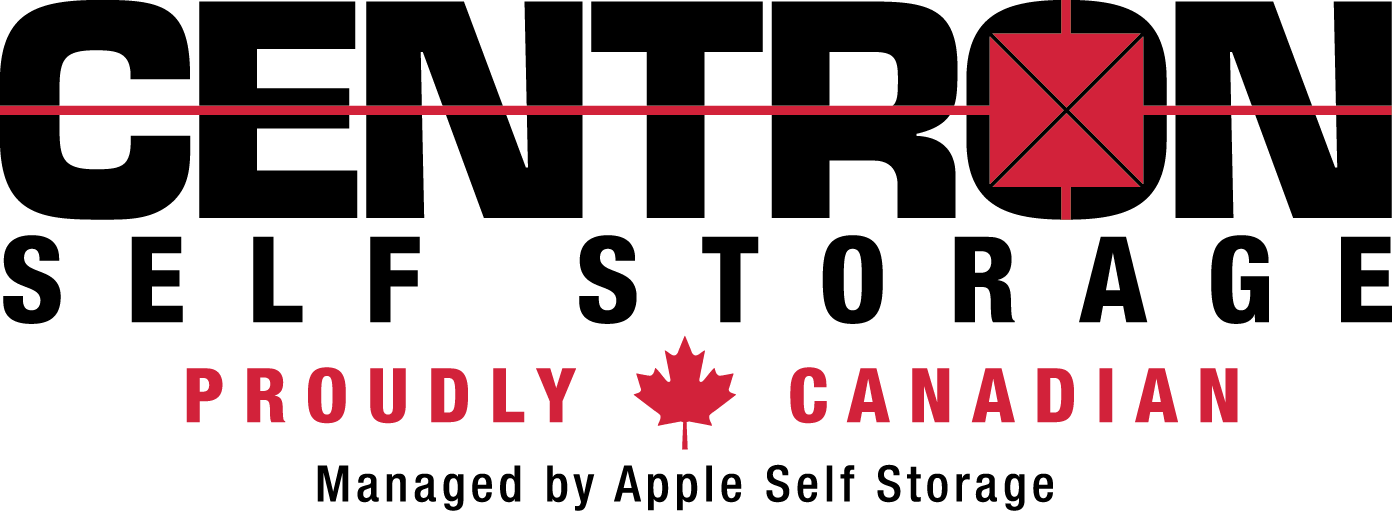Decluttering Home Using Storage Facilities in Downsview
Finding enough room for our valuables in the busy Downsview area might be challenging. Let decluttering take center stage as you work to create a tidy and welcoming living space.
Learn the art of decluttering while you leverage the use of storage facilities in Downsview, North York. Discover some of the most effective techniques that will allow you to organize our home while saving the items you cherish the most.
Assess Your Clutter
Before you start getting things in order, list down all of your belongings to help you decide what items you want to keep, what you should donate, what you need to throw away, and what you should put in the storage unit. Consider classifying them using labels like “Keep,” “Donate,” “Discard,” and “Store” to make the process smoother. You may choose wisely regarding your belongings by using this straightforward method of categorizing.
Go Room to Room
Try tackling one room at a time to make things simpler and avoid feeling overwhelmed. Start with a little area, such as a bathroom or closet. Move on to larger rooms later, such as the living room or bedrooms. With this systematic approach, the chore becomes more manageable, and you’ll experience a feeling of accomplishment as you finish each area. You’ll make progress and maintain motivation throughout the decluttering process if you approach it in this way.
Use Self Storage for Seasonal Items
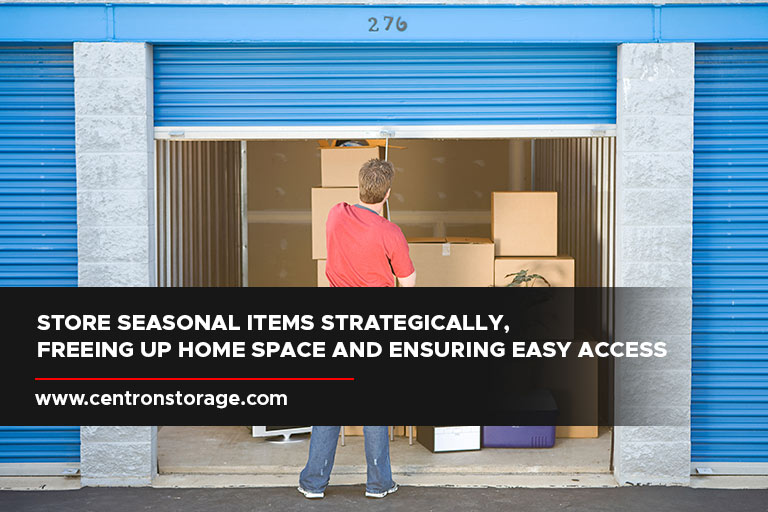
Winter clothing, Christmas ornaments, and sporting equipment may take up precious room in your home all year long. Keeping these things arranged and accessible can be accomplished by renting a self-storage facility. Climate control in contemporary self-storage facilities ensures the security of your valuables. This guarantees that your belongings will be in excellent condition when you need them. You may free up space at home with self-storage without being concerned about your belongings getting damaged.
Create a Customized Storage Plan
Each home has different demands for storage. A personalized storage strategy may be quite beneficial if you have special valuables like antique furniture, priceless artwork, or objects with sentimental significance. Choosing the ideal storage unit size and features to fit your stuff precisely can be guided by industry experts. You can keep your priceless possessions secure and well-arranged with their help.
Pack and Label Thoughtfully
Effective packing is the key to getting the most out of your storage space. To protect your stuff, put them in sturdy boxes. To identify the contents of each box, remember to label them. In this manner, items in storage for some time may still be quickly located when needed. Labelling your boxes will keep you organized and reduce time spent later seeking items.
Implement a Rotating System
If you sometimes use something but don’t want it to take up too much room in your home, consider employing a rotating system. Keep the items you use frequently at home and store everything else. Then you can swap them out as needed to allow you to still access the items you need, but not all at once, and maintain your house organized and clutter-free.
Regularly Review and Reorganize
Decluttering is a continuous process that you don’t just accomplish at once. Establish frequent inspection times to examine what’s in your storage facility. You can alter your storage strategy if your needs change. Over time, this keeps your house in good order, giving you full control over your belongings. The secret to keeping your home organized long-term is to assess and modify your storage arrangement regularly.
If you’re looking for reliable self-storage solutions, consider exploring the options offered by Centron Self Storage. Our expert guidance and reliable storage facilities in Downsview can assist you in achieving a clutter-free and harmonious living space. Reach out to us today to get started!
Why Decluttering Is Important
Self-care takes many forms. Sometimes, all you need is a chance to relax. However, relaxing is never truly complete unless you also pay attention to your environment. Decluttering your surroundings is a great way to accomplish just that. Getting rid of clutter improves our physical and emotional health.
For one thing, clutter and disorder may be distressing, which may explain why Marie Kondo and minimalism continue to have such a devoted following. After all, organizing your belongings not only makes it simpler to find what you’re searching for, but it may also boost your mood and state of mind in a variety of ways.
Here are some of the life-changing magic of tidying up:
- Reduce anxiety
Hoarding is when you keep items you don’t really need, don’t cherish, or don’t offer any value to your life. Clutter can negatively impact your life in many ways, like distracting you and removing tranquility from your life and house. Clutter may also have a negative influence on your health and happiness. Stress, despair, anxiety, and insomnia are all consequences of living in a messy environment.
Maintaining your house is less stressful when it involves less time and energy. You can also rest, relax, and enjoy your house more because it is easy to keep clean. All of these contribute to a greater sense of joy and calm in your house, which is why decluttering can be so therapeutic.
- Reduce financial stress
One of the benefits of decluttering often overlooked is it can actually help you save money. When you clean, you may discover stuff that you had forgotten about. Consider cleaning up your closets, pantry, and medicine cabinet. There’s a good chance you’ll come upon items from your shopping list.
Knowing what you have enables you to analyze your needs and budget your spending more effectively. You’ll start to think twice about buying stuff on the spur of the moment once you start placing more worth into your space. Because you’ve discovered a new appreciation for orderly, uncluttered places, you’ll become much more cautious about what you buy. And everything you can do to reduce financial stress is beneficial to your overall well-being.
- Can be a good exercise
Although getting up and moving might be challenging at first, exercise makes us feel more invigorated. Cleaning is sometimes overlooked as a form of exercise, but any effort helps. In the same way that having fewer things means spending less time managing them, having less stuff means spending less time maintaining them. You’ll have more time and energy to focus on the things that are really important to you, such as your work and hobbies.
- Helps your productivity
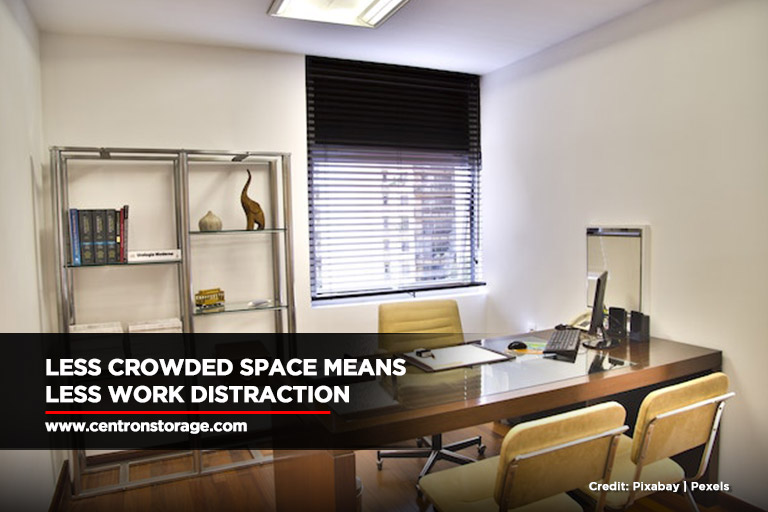
When the house is crowded, your thoughts may rapidly become a jumbled mess, making it difficult to focus and finish even the most basic chores. Exposure to cluttered, disorderly situations might affect your awareness, concentration, and focus, as well as exhaust your cognitive resources. Also, living in a congested environment is linked to lower productivity and more persistent procrastination.
So, if you work from home, this is very crucial to consider. Eliminating physical mess from your house can help remove the distractions, helping you accomplish more of your to-do list.
- Feel more secure
Another reason why decluttering your home is important is that clutter could be a potential safety issue. If there are cables on the ground, for example, someone could trip on them and fall. It can also become a health risk if piles of junk have started to collect dust or bugs. Furthermore, clutter can cause stress or friction amongst family members, particularly if they have differing views on what constitutes tidiness.
Though “home” is often thought of as a safe and comfortable place, clutter might weaken that sense of security. A study found that women who rated their houses as more cluttered had higher levels of stress hormones and are in a sadder disposition throughout the day than those who viewed their homes as more peaceful and restorative.
- Saves time
Even while it might not seem like much, searching and not knowing where you placed your belongings can be quite time-consuming and frustrating. Fewer possessions mean less “stuff” to care for, clean, and manage. You now have more free time to devote to the things that are important to you. It may be more time to spend with the people you cherish, more time to engage in a passion project, or more time for yourself.
- Creates more space
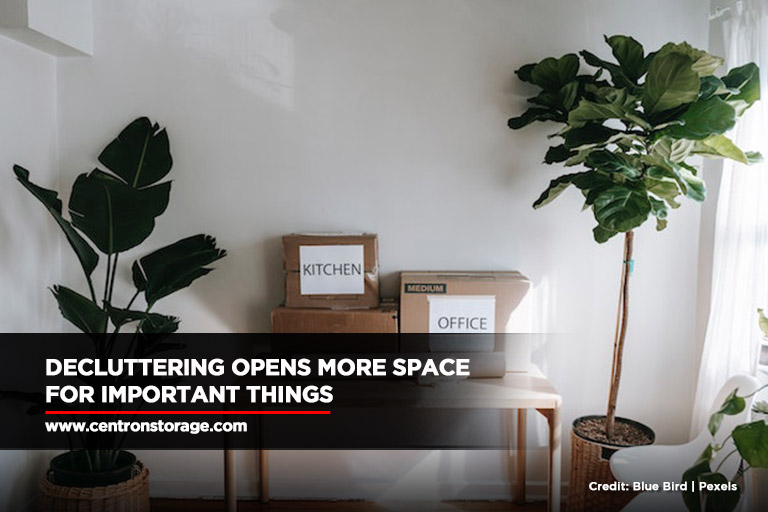
Decluttering is sometimes mistaken for being a minimalist, but that doesn’t have to be your objective. You may only concentrate on the items in your home that have value. Not everything needs to be thrown out while decluttering. Instead, it is letting go of things that you don’t truly need, enjoy, or utilize in order to make room for the things that are most important to you.
You may use the extra space to exhibit special sentimental objects that you love rather than retaining the bunch of books you know you’ll never read. Decluttering not only makes room in your house but also gives you more time and attention to devote to the things that are most valuable to you. Removing the superfluous makes room for the things you actually care about, so decluttering and self-care go hand in hand.
- Improve health habits
The health benefits of decluttering are plenty. According to research, decluttering can result in better sleep and other healthy practices. A strengthened immune system, assistance in maintaining a healthy weight, and a decreased chance of developing significant health issues like diabetes and heart disease are just a few advantages of getting more restful sleep.
It’s important to keep in mind that decluttering doesn’t have to be done all at once if the work seems too onerous. Focus on one area at a time or allot simply 15 minutes every day. Decluttering is a task that takes time to complete, much like improving your health.
Your life will be much simpler if you have a place you feel at ease. It will also have a great effect on your mental health. It is beneficial to incorporate decluttering into your self-care regimen because your environment has a significant impact on your overall health and quality of life.
When you’re up for extreme decluttering and looking for a place to store the items that no longer give you joy, go to Centron Self Storage. Our self-storage rental in North York uses state-of-the-art technology and thoroughly trained employees to keep your items safe round the clock. Call us at (416) 739-0000 to reserve.
How to Declutter Your Storage Unit Like a Pro
People pay for storage rental in North York where they can temporarily store their unused belongings. Eventually, years of usage can fill up your storage unit. Facing boxes full of years’ worth of clutter can be overwhelming. You might even think that you require more storage space to accommodate all your unused possessions. However, you do not need to invest in a larger storage unit. The best solution to your problem is to declutter.
Why You Need to Declutter Your Storage Unit
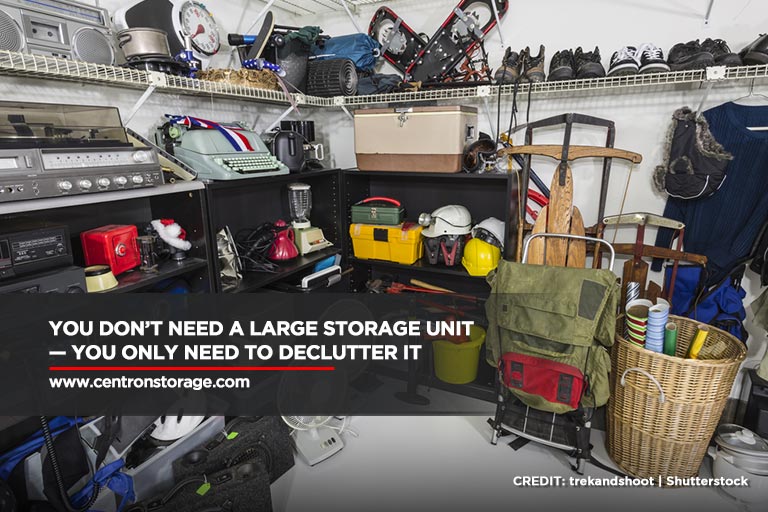
Often, many people only visit their offsite storage units to store excess possessions and forget about them. Since an offsite self-storage unit rental is kept out of sight and out of mind, decluttering may not be high on your priority list. However, the state of your storage room — especially if you haven’t cleaned it in months — can weigh on your mind.
Decluttering your storage unit can give you peace of mind. By doing so, you can rest assured that your unused belongings are safe, organized, and easily accessible the moment you need them. This can make your life easier in many ways. You don’t have to turn the entire place upside down to locate specific items — like a ski boot for your annual winter vacation or some special old memorabilia you need to retrieve. Additionally, having a storage space doesn’t necessarily mean you should store all your possessions — even the damaged, unnecessary ones — just in case you “might” need them again.
When decluttering your rented space, sort through your items and identify which ones to keep, discard, and donate. It will help you free up more space to store items that are truly essential to you.
Tips for Decluttering Your Storage Space Without Feeling Overwhelmed
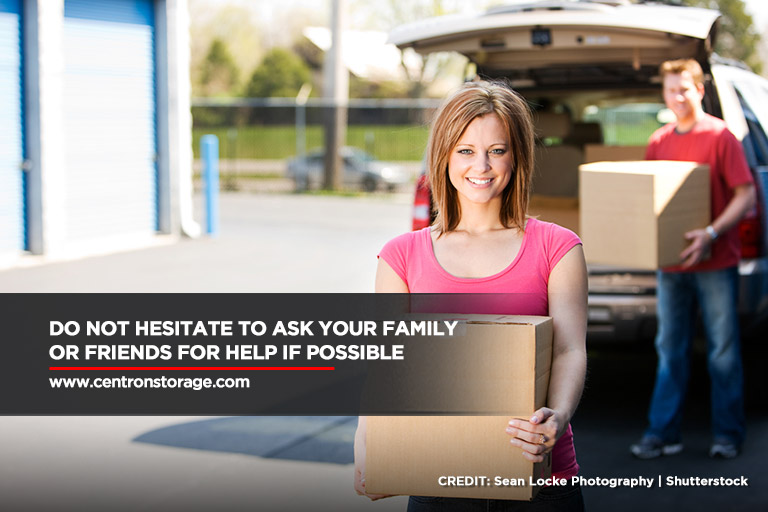
When the amount of clutter starts to accumulate, it can be impossible to retrieve an important item whenever you need them the most. Not only can this inconvenience you, but years’ of clutter and disorganization can be the biggest hurdle in cleaning up your storage unit. When cleaning feels too daunting, it can paralyze you from making a change. To help you take the first step, we have rounded a checklist to serve as a guide on how to declutter your storage unit in no time.
- Take inventory of your storage unit content
The first step for decluttering your storage unit is scanning and taking immediate stock of its contents.
-
- List down what your see: Start jotting down visible large items. Count the number of boxes and list down what you need to sort through to help you determine the time you need to declutter your unit.
- Make an open space inside or outside the unit: If you have limited space, carve out a free corner as your processing area for the next step. However, if you do not have enough room inside, simply set up a temporary pop-up canopy where you process all your stored belongings outside the unit. However, make sure not to block anyone else’s unit and clean up your mess after.
- Check the contents of the boxes: Once you have organized the boxes, take a look at their contents. This applies to unlabeled boxes. If you see valuable, fragile, or important items, be sure to make quick notes for each box.
Creating a rough inventory before sorting your belongings can give you an idea of what you need to be decluttered and organized.
- Make a plan and enlist the help of your friends or family
After the inventory, you do not need to start right away, especially if you do not have an actionable plan. Knowing the best approach helps eliminate the feeling of being overwhelmed and avoid the most common mistake of storing items in a storage unit. Take time to decide on when to start your decluttering projects.
Prepare what you need to bring—bags, shelves, labels, cleaning tools, boxes and moving supplies. Give yourself enough time to clean and organize your unit. Depending on the size of the job, you might need more than a day of decluttering. If you need to urgently clear out the unit, store items in the boxes or bags so you can easily sort through them in your garage or other location.
- Sort items into categories
When sorting your belongings, prepare 4 boxes and categorize them into the following: “keep”, “store”, “sell/donate”, and “dispose”.
Put all the items you want to bring back home into the “keep” box. For those items that you want to set aside, place them into the “store” box so you can return them to the storage unit. Anything that is in good condition and is no longer needed should be in the “sell/donate” box. Lastly, discard items that are broken beyond repair or those without value in the “dispose” box.
- Clean and organize your unit
If you are done sorting your items, it is time to give your storage unit a clean. After getting rid of dust and debris, organize all the things you need to store in the unit.
-
- Get as many items off the floor if possible. If your rented storage unit comes with shelves, optimize every elevated surface. Items, such as tote bags and seasonal tools can be hung on walls to keep them organized. You can also use small pallets to keep large boxes off the floor to keep them safe.
- To protect your sofa, stuffed chairs, and other furniture from damage, wrap them properly using heavy-duty plastic or specially designed plastic mattress cover.
- Be sure to label boxes by content or purpose. Keep the label facing outward so you can easily read and access them whenever you need.
- Designate a wall for a pegboard or heavy-duty shelf. This allows you to hang your bicycle and organize tools and other important equipment for easy access.
At Centron Self-Storage, we welcome our customers to clean their self-storage units whenever they can, and with your help, we can continue to provide all of you with a clean and well-maintained storage facility where you can safely store all your belongings.
If you are looking for a safe, clean, and secured self-storage in North York, call Centron Self Storage at (416) 739-0000.
Tips for Couples Moving in Together
Are you and your significant other moving in together? If so, congratulations! This is an exciting time in your relationship. However, it can also be a bit stressful. There are a lot of things to think about when moving in together, from dividing up the bills to deciding who will take care of the dishes each night. In this blog post, we will provide you with some tips for making the transition as smooth as possible. Read on for advice on everything from setting ground rules to organizing your new space.
The Benefits of Moving in With Your Partner

For many couples, moving in together is a big step in their relationship. One of the biggest benefits of living together is that it can save you money. You can split the cost of rent, utilities, and other bills. You may also be able to get discounts on things like car insurance.
Another plus is that it can be more convenient than living apart. You won’t have to commute to see each other, and you’ll always have someone to help with things like groceries or taking out the trash.
But there are also some potential negatives to moving in together. It can be difficult to adjust to living with another person, and you may find that you don’t have as much privacy as you’d like. There’s also the potential for arguments over things like cleaning or dishes. If you’re considering moving in with your partner, it’s important to weigh the pros and cons carefully before making a decision.
Helpful Tips on Moving in With Your Partner
No matter how excited you are about moving in with your partner, you’re probably feeling a little nervous too. Fortunately, there are some things you can do so that you and your partner are more prepared for your new living situation.
Do a Trial Run Before Officially Moving in Together
One of the best ways to make sure you’re ready for the move is to do a trial run first. This way, you can figure out what works and what doesn’t before you’re actually living together. You might find that you don’t like your partner’s habits as much as you thought you would, or that you need more personal space than you realized.
A trial run will help you figure all of this out before it’s too late. Plus, it’ll give you a chance to really bond with your partner and make sure you’re both on the same page about the move. It’s important to remember that how long before moving in together depends on what you and your partner are most comfortable with.
Think About What You Want to Keep and What You Want to Get Rid of
Moving in with a partner is a big step in any relationship. It’s a time when you’re really starting to build a life together, and that means making some decisions about what kind of life you want to have. One of the most important decisions you’ll make is what to do with your stuff.
Depending on how much stuff you have, and how much space your new place has, you may need to downsize before moving in together. That can be tough, but it’s worth considering for a few reasons. First, it will help you save money on moving costs. Second, it will help you avoid arguments about who gets to keep what.
Additionally, it will give you a chance to start fresh together, with only the things that are really important to both of you. That being said, you may want to consider looking into your storage options.
Make a Plan for Shared Expenses
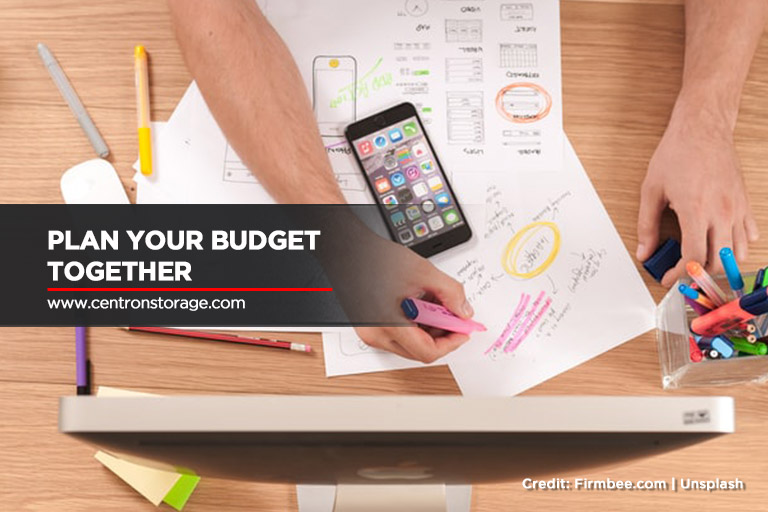
One of the biggest financial challenges that couples face is managing shared expenses. When you live together, it can be easy to let bills and other costs pile up, which can put a strain on your relationship.
To avoid this, it’s important to sit down with your partner and come up with a plan for how you’ll handle shared expenses. This doesn’t have to be complicated – you can simply decide who will pay for which bills, and how you’ll handle shared costs like groceries. However, taking the time to develop a budget and establish some financial ground rules can help to keep your relationship healthy and stress-free. Plus, it will give you both peace of mind knowing that you’re on the same page financially.
Talk About How You Will Handle Guests
Before moving in together, it’s important to have a discussion about how you’ll handle long and short-term guests. Do you want to allow overnight visitors? How often can people stay? What are your expectations around hosting parties or other events?
By talking about these things in advance, you can avoid conflict and misunderstanding down the line. If you’re not on the same page about guests, it can be a source of stress and tension in your relationship. agreed-upon guidelines will make it easier to relax and enjoy having people over.
Plus, if you ever do have a disagreement about guests, you’ll already have a plan in place to fall back on.
Decide Who Will Be Responsible for Which Chores
Before you make the move, it’s important to sit down and discuss who will do what tasks. Many couples find it helpful to divide up chores based on interests and skills. For example, if one person enjoys cooking, they might take on meal prep while the other person handles grocery shopping.
Or, if one person is better at keeping things tidy, they can take on most of the cleaning. Ultimately, the key is to find a system that works for both of you and prevents any feelings of resentment. If you’re both flexible and open to compromise, you’ll be sure to find an arrangement that keeps your home (and your relationship) running smoothly.
Don’t Forget About Your Me Time
When you move in with a partner, it’s easy to get caught up in the hustle and bustle of everyday life. Between work, chores, and spending time together, it can be tough to find time for yourself. However, it’s important not to forget about your alone time.
Taking a few minutes each day to do something that you enjoy — whether it’s reading, taking a walk, or just taking a moment to relax — can help you stay sane and stress-free. Additionally, making time for yourself can help to improve your relationship with your partner. If you’re always happy and well-rested, you’ll be in a much better mood to spend time with your partner.
Get Ready for Your New Beginning
For lots of couples, moving in together is the first step in planning a future together. Now that you’ve had time to read our checklist of moving in together, you can feel a little more prepared.
If you need a place to store some of the belongings you won’t be moving into your new space, we can help. At Centron Self Storage, we have a variety of storage lockers in North York as well as storage unit tips. Contact us today to learn more about our services.
12 Tips for Safely Moving Your Items Into Storage
Disassembling large or heavy furniture can help you avoid injury. When doing so, keep all the dismantled parts (such as bolts, screws, or other small pieces) together to prevent confusion when you reassemble the item in your new house. For example, unscrew the legs when moving a table, and extract the draws when moving a desk. If you have furniture prone to scratches like coffee tables, tabletops, and headboards, wrap them in protective padding. You can rent padding from storage facilities or moving companies.
Moving Heavy Objects Safely
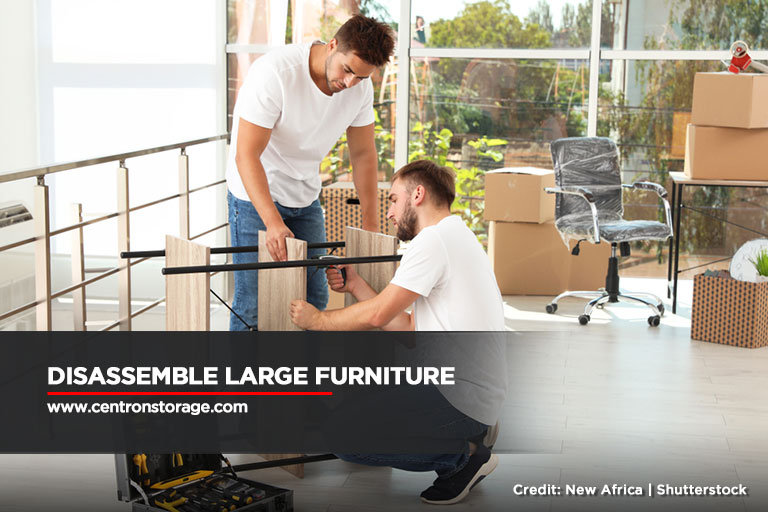
Trying to move boxes that are too heavy will suscept you to injury and potentially damage your belongings. Thus, limit the weight of your boxes to under 50 pounds if possible. Furthermore, make sure you’re putting heavier items at the bottom of the box and lighter items at the top to balance it out.
Moving Fridges Safely
Move the heaviest and largest items first, including the fridge, washing machine, dishwasher, and stove. Additionally, make sure you get a few people to help you with carrying these items. Put the heaviest objects on the sides of the trunk to keep things balanced, and make sure all items are upright. Additionally, items like mirrors, mattresses, box springs, couches, tables, and headboards should go against the longest walls of the trunk. The heaviest and largest boxes should follow this. Fill as many of the truck’s crevices as possible to prevent items from sliding while you are driving.
Find a Truck With a Ramp
If you’re moving your items into the moving truck on your own, you should highly consider getting a truck with a loading ramp. Though the cost of renting a truck without one may be less expensive, the struggle and hassle of lifting every piece of furniture and box high enough to fit it properly into the trunk could leave you with sore and potentially strained muscles. Furthermore, it could take hours.
Use the Correct Size Boxes
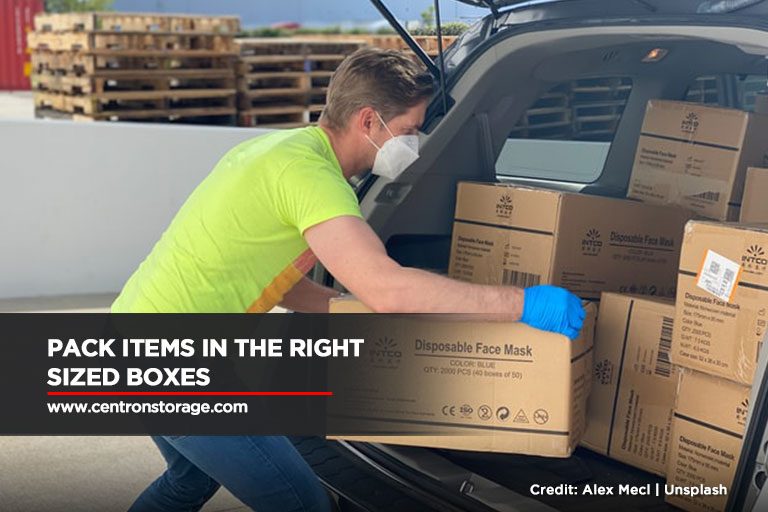
Pack books or other heavy items in small boxes while packing pillows, linen, or other light objects in more giant boxes. Professional movers commonly complain about packing large boxes with heavy items, which makes the job more difficult and are more likely to break. Both of these factors could potentially cause injury to the movers.
Protect Fragile Items
Fragile items should be the last to be put in the trunk and should be placed so that they won’t move while they are being transported. Consider packing fragile items in boxes with light items like linens, clothing, pillows, or towels to provide some cushioning and prevent them from breaking or getting banged up. Alternatively, you could purchase bubble wrap, which will prevent dishes from crashing into each other and is inexpensive.
Pack the Kitchen Carefully
There are many different types of kitchen items you’ll need to pack for a move. Here are some tips for packing your kitchen:
- Cover each dish with packing paper before wrapping them with more paper in bundles of 5 to 6.
- Pack dishes on the side, not flat.
- Use bunched-up paper as padding
- Pack cups and bowls inside each other, putting the paper in between. Then wrap 3-4 in a bundle.
- Pack all dishes in dish-barrel boxes.
- Protect glasses using cardboard dividers, wrapping them in many layers of paper.
Pack Your TV Properly
Plasma TVs need to be packed more carefully than other types of furniture, as they need to be shipped in special wooden crates and be damaged if you don’t have the original box and lay them down flat. If you pack your TV on your own, double-box it and put it inside another box that you have padded using packing paper.
Hold Onto Important Records
Don’t pack your important records into boxes, but keep them in a safe place where they won’t be lost. This may include your:
- Birth certificate
- Social security card
- Passport
- Tax documents
- Chequebooks
- Original copies of wills
- Driver licenses
- Investment papers
Tape Your Boxes Well
Seal the top and bottom seams using a few pieces of tape. Afterward, wrap all the way around the top and bottom edges of the box, as that is where stress is most concentrated. This will keep your items secure and free from damage.
Moving Expensive Art
If you want to keep your artwork safe during the moving process, understanding how to pack it correctly is essential. Don’t wrap oil paintings in normal paper, as they will stick. When packing any artwork, use masking tape to make an X across the glass, strengthening it and keeping it together if it shatters. Afterward, wrap the pictures with bubble wrap or paper before putting them in a frame box. Make sure to also stick cardboard between each framed piece to protect them.
Don’t Leave Empty Space In The Boxes.
Make sure that you fill gaps in your boxes with packing paper or light items like clothing or towels. If your boxes are packed loosely or feel unbalanced, movers might refuse to move them because this can lead to damaged or broken items.
Are you looking for storage near you? Search no further than Centron Self Storage! We ensure that your belongings are being kept safe 24/7, employing fully-trained staff and state-of-the-art technology. Contact us at (416) 739-0000 or visit our office at 4500 Chesswood Drive North York, ON M3J 2B9 if you’re interested in our services.
How Self-Storage Can Benefit Home Stagers
Looking to sell your home? When putting your house on the market, you’ll need to rely on more than just the house’s location, size, and price to attract buyers. The condition of the house, as well as the physical appearance of the interior and exterior, will determine the number of offers and potential buyers you receive. A home that appears to not have been properly maintained will sell for much less than a home that looks to be a product of hard work and dedication, with beautiful furniture and decor.
Here are some ways that self-storage can benefit home stagers, helping you make your home more attractive at a low cost. You can call on professional home stagers to help you decorate or add furniture and appeal to more buyers and receive better offers, or you can attempt home staging yourself by implementing your own creative tactics.
What Is Home Staging?
Home staging is the process by which real estate agents and home sellers prepare a home to be sold. This includes switching out decor, removing items from the home, and making adjustments to the living space to attract buyers by helping them see themselves in the house. It can simply mean removing a few items from the walls and shelves or can be a total furniture makeover. It can make the home easier to market, drawing more buyers from listing photos and other visual marketing mediums.
Reduce Clutter
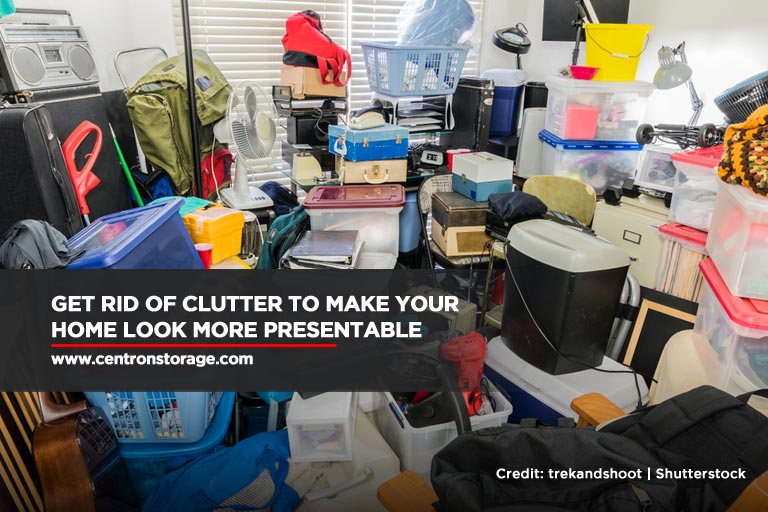
In real estate, first impressions are crucial. For those planning to sell their homes soon, it’s important to make your place look as tidy and aesthetically pleasing as possible for potential buyers who are touring. Thus, renting a storage unit will give you a place to store unwanted or unnecessary items until you can move them to your new location, giving your home a less cluttered and more appealing look to present for viewings.
Make Room For Creativity
Once you remove clutter, you can focus on using new, better-looking furniture and decor that will make your home more attractive. Consider hiring professional home stagers, who will come with their own furniture and decor to help the space come alive the way it was intended to. Otherwise, you can use your favorite furniture, thrifted pieces, and/or borrowed items to add more intrigue to your home.
Designing and living in a home is very personal, and there’s a lot of variety when it comes to style and taste. A minimalistic, neutral look is often the best way to go when staging a home, as it will appeal to a wider audience than a look targeted towards a particular niche. Some people even choose to leave with only the bare minimum or empty so visitors can envision their decor and ideas for the space. Thus, you may want to store away any bold or excess furniture. You’ll at least want to remove any personal items before viewings so that visitors can imagine themselves living in the space as opposed to feeling like it already belongs to someone else.
Protect Items
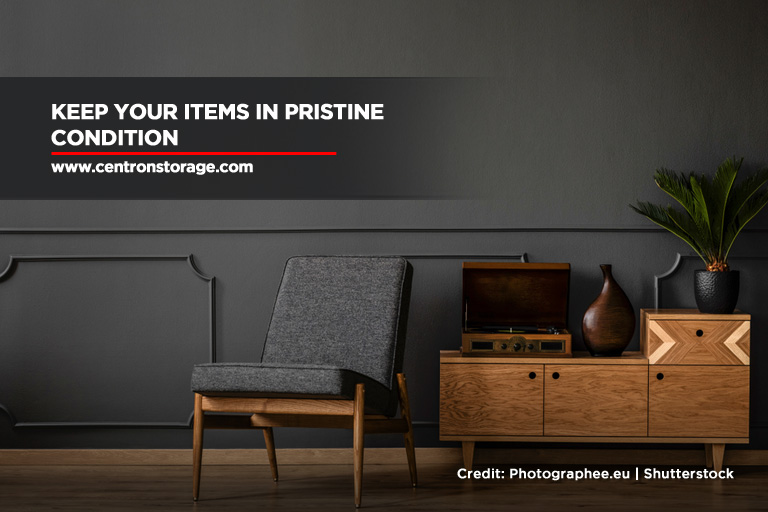
Another benefit of having a self-storage facility is that you have a secure place for your items to be safely tucked away during your home staging and selling process. Equipped with surveillance cameras, security lighting, heavy-duty fences, and electronic gate controls, these facilities will deter theft so you don’t have to worry about your items being stolen.
Make Your Move Easier
Self-storage helps you get a head start on your packing and moving. Rather than leaving things for the last minute, begin moving items from your house to your self-storage unit at your own pace. This creates space in the house for staging and will help make the packing process smoother and easier in the long run.
Climate Controlled Advantage
With self-storage, your items will be guaranteed protection from the elements and kept in a climate-controlled environment. This will help keep your furniture in solid condition, as hot, humid, or extreme temperatures can damage or destroy certain items. Rather than storing your home furniture and decor in your garage, attic, or basement, use a climate-controlled storage unit to ensure that your belongings will remain in tip-top shape, even if you have to leave them in storage longer than anticipated.
Prioritize Key Spaces
Not all rooms hold the same importance when it comes to staging. This is a positive thing for sellers who may not have enough resources to put towards a full home staging. Knowing what rooms are important (the top four being living rooms, master bedrooms, kitchens, and dining rooms) enables sellers to prioritize certain areas when staging. Avoiding the rooms that don’t make much of a difference allows you to be as efficient as possible, maximizing the amount of impact while doing less work. Using self-storage, you can pack away excess items in these key spaces to make these areas look as attractive as possible.
Sell Faster
The last thing a seller wants is to find themselves on a stale listing. The longer a house is on the market, the more difficult it can become to sell. Thus, there’s a lot of incentive to get your place sold as soon as possible. 25% of sellers agents reported a large decrease in days on the market for staged homes. Staged homes tend to sell faster because it helps buyers evaluate whether or not they can see themselves
in the property and see the potential for the space. By packing away excess items in self-storage, you can make your home look more neat and polished for pictures you want to post on listing sites.
Overall, self-storage can be a huge help during the home staging process and throughout the moving process. With extra effort and planning, home staging can help your house look its very best to attract the right buyers and offers. Find affordable, convenient self-storage near you!
Entrust your belongings to Centron Self Storage. We offer clean and secure storage units in North York. Reserve yours now by calling us at (416) 739-0000!
Useful Tips for Storing Your Holiday Decorations
The Holidays have ended. For many, this could mean taking down their decorations. While festive decorations are a great joy during the holidays, they can be a pain to pack up and store.
Holiday decorations can quickly fill up your home and eat up some precious storage space. Before your Christmas ornaments clutter up your garage, basement, or attic, you need a proper storage solution now. This year, why not try renting out a self-storage unit? After all, you only use these goods once a year.
When keeping decorations, take extra care to ensure that they remain in good shape. Follow these tips on organizing and storing your holiday decorations.
- Take Photographs of Your Décor
Has there ever been a time when you couldn’t remember where you placed your items, which box you put them into, or which décor you used as the dining table centrepiece? Holiday decorations come in many colours, shapes, sizes, and materials. It’s easy to misplace and forget them, especially when you’re storing them away.
To save you from the hassle, make an inventory of your decorations. Better yet, take pictures of the decorations before putting them away for storage. Grab your mobile phone and start photographing. Take pictures of which containers you placed them. That way, all you have to do is scroll through your albums to know where exactly to get them.
- Purchase Plastic Bins
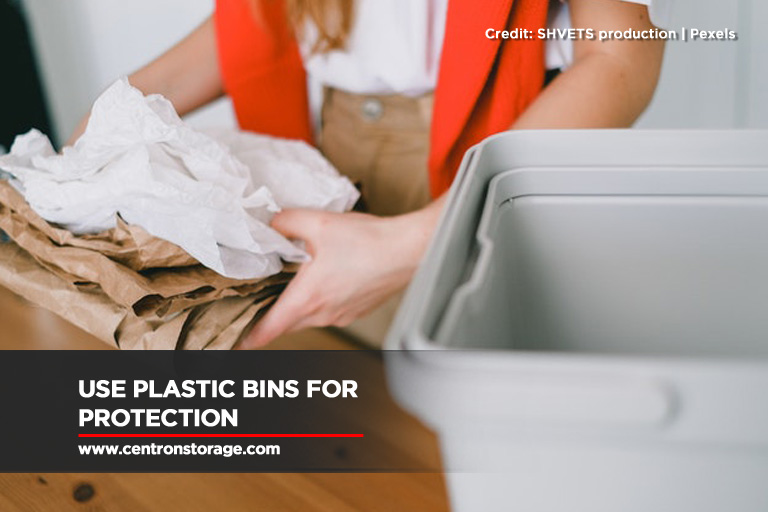
Many decorations are extremely fragile. It will defeat the purpose of safekeeping if they break while in storage. For your holiday decor storage containers, invest in some robust plastic containers, rather than in battered cardboard boxes year after year. These plastic bins can be stacked without fear of crushing objects in the bottom bin while in storage. You can also colour code them so you can tell which bins in your storage facility hold seasonal decorations.
In case plastic containers aren’t available, it’s a good idea to invest in cushioning supplies, like bubble wrap or packing peanuts, to avoid breakage while packing and storing your Christmas gifts. You can also utilize old clothing and blankets as DIY cushioning alternatives for your holiday decorations.
- Keep Your Wreaths and Garlands in Good Shape
There are several options for wreath and garland storage, just like there are for all of your other Christmas decorations. Place Christmas wreaths and garlands in their original boxes and store them horizontally on a shelf. If you no longer have their original boxes, look for solid containers that will protect any ornamental bows and ornaments while preserving the shape of these objects. They can also be hung on hooks on a pegboard in your storage unit. Cover them with a lightweight dry cleaning bag for added protection. Do not stack wreath bags on top of one another since this may cause them to become deformed. - Maintain Your Christmas Tree
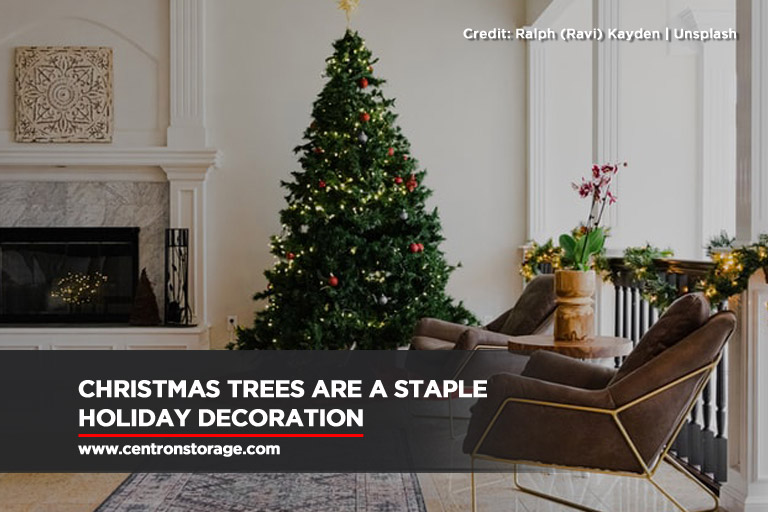
The Christmas tree is probably the most important holiday decoration of all, so proper attention must be given to it. Despite the fact that fake trees are fairly resilient, storing your tree in its original box is not a good idea. The tree will not look as attractive if it has to be squeezed into the box and reshaped every year. Besides, the box will deteriorate with each passing year, making it susceptible to insect infestation.
There are a variety of tree storage container solutions available to safeguard and maintain your tree. If you can dismantle your tree, then do so accordingly and place them inside plastic containers. Alternatively, keep your tree in perfect condition by storing it in climate-controlled storage. This is especially critical if you have a frosted, flocked, or white tree, as they don’t do well in cold weather.
- Take Down Any Large Decorations
One of the many head-scratching moments of storing holiday decorations is figuring out how to store large outdoor Christmas decorations. While it may be simpler to take the ornaments out and put them upright in a storage container, you risk damaging your holiday decorations. Instead, remove any loose elements and disassemble major embellishments instead. Place each item in a box. To avoid damage, wrap fragile things and remove glass elements from the base of the displays. When stacking up, place the largest or heaviest item at the bottom and the lightest on top to avoid squashing everything in between. It’s preferable to store your Christmas decorations in sections rather than as a whole. - Take Care of Christmas Ornaments
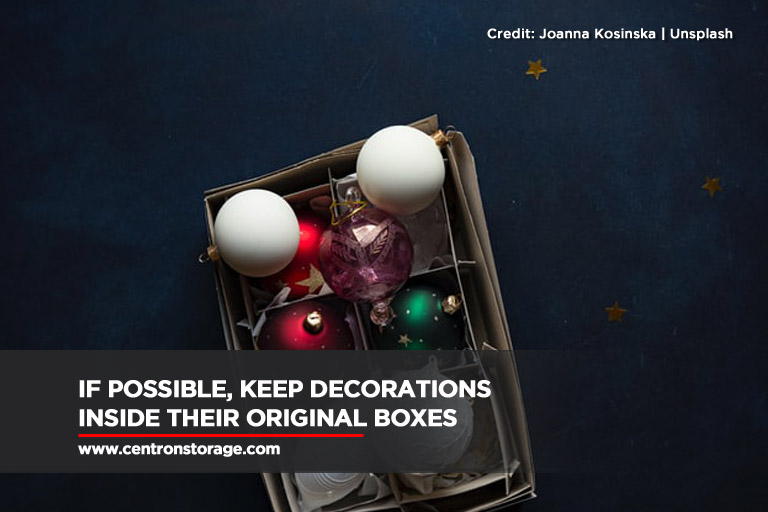
Most ornaments are invaluable treasures because they were either handmade by family members or were passed down as heirlooms, so you need to be creative with your holiday decoration storage ideas. You may buy specially constructed boxes to hold decorations at your local home craft store. You can also get creative and employ DIY ways to store smaller ornaments, such as utilising plastic cups enclosed inside a box or a cardboard egg crate. Keep the boxes for larger or unusual shaped ornaments if at all possible. If you don’t have any boxes, wrap the ornaments in tissue paper gently.
- Keep Your Christmas Linens Fresh
Before storing your Christmas table linens, bed linens, and towels, make sure they are clean. Over time, stains can oxidize and become tough to remove. Tissue, newsprint, and cardboard should not be used to wrap linens since these may also cause the fabric to discolour, or worse, the ink can leave marks and stains. Fabric can also be harmed by plastic and hangars. These goods can be stored on an extra shelf in your linen closet if you have the space. A luggage that you no longer use in your storage container is a better solution. Remember to keep these pieces in a climate-controlled location to preserve their beauty and prevent additional harm. - Be Careful With the Candles

To avoid scratching and discolouration, wrap candles in old socks or cellophane.
Plastic wrap or wax paper should not be used since they can stick to your candles. Keep them flat, out of direct sunlight, and in a relatively cool location unless you want melted, deformed globs of wax, of course. After you’ve finished wrapping them, keep them in a box or crate, or even in your ornament storage boxes, in a climate-controlled section of your home or storage facility.
- Untangle Your Christmas Lights
String lights are by far the most difficult Christmas decorations to pack. These popular decor are both fragile and prone to tangling. There is, however, a simple approach you may use to make string light packing (or any wired electronics, for that matter) easier to store — untangle and wrap. Carefully removing lights from your structure to minimize knotting. Next, grab a piece of cardboard and loop your lights around it. Don’t forget to place them in a cool and dry place.
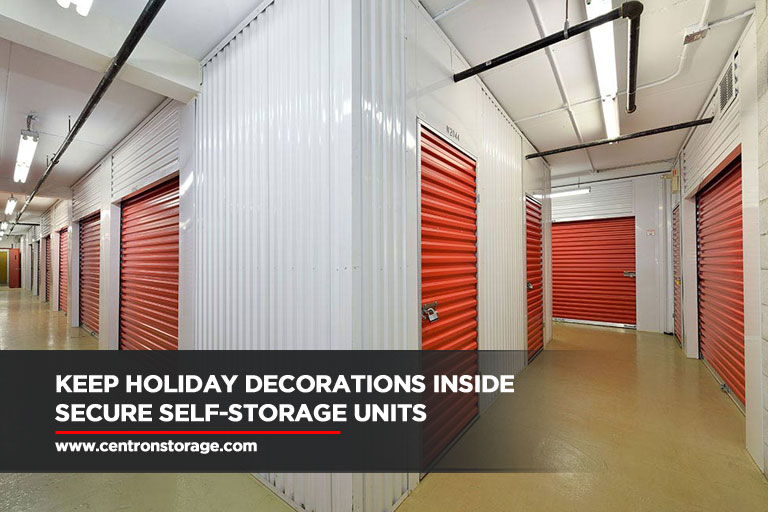
Many homeowners like decking their halls with festive lights, ornaments, statuary, and other decorations during the holidays, yet find them a hassle to store at the end of the season. These tips on Christmas ornament storage will help you save time and effort.
If you need a place to store your valuable items, turn to Centron Self Storage. Our storage units in North York are ready to keep your decorations safe and good as new. Call us at (416) 739-0000 to reserve a unit.
Helpful Tips for Storing Tires
Due to their size and the extra procedures required to keep them in good shape, storing tires may be a stressful chore. But, sometimes, you may not have any choice. When seasons change, for example, storing summer tires in winter and winter tires come summer is a must. Because temperature and exposure to the elements are the two most critical factors that affect the condition of a tire, it’s important to consider how to store your tires during the off-season.
All tires will inevitably deteriorate, but some things could be done to slow down the process. If you don’t know where to begin, you’re not alone. Here are some tire storage tips, so you can get the most out of your tires:
- Remove tires from vehicles
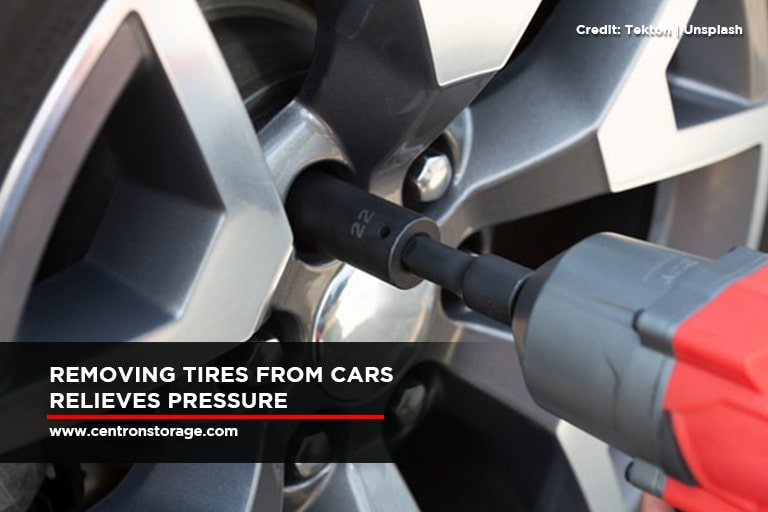
If you’re storing a car for more than a few months, take your tires off the car if at all possible to ensure long-term care in storage. Flat-spotting can occur if the tires are left on the car for longer periods. Removing the tires also allows you to maximize the storage conditions for your tires while also eliminating common causes of strains such as vehicle weight, temperature fluctuations, and so on.
When you are unable to remove the tires from the vehicle for storage, you must take particular precautions to ensure that the tires are correctly stored. It’s best to start by removing the weight from the tires by mounting the vehicle on jack stands or other load-bearing equipment. If you can’t remove the weight from the tires, it’s best to leave the car fully empty so that just the bare minimum pressure is placed on the tires. Make sure to take the automobile for a ride every few months at the very least to keep the tires in good shape. Tires perform best in service because motion distributes oil uniformly throughout the rubber, preventing it from drying out.
- Clean your tires before storage
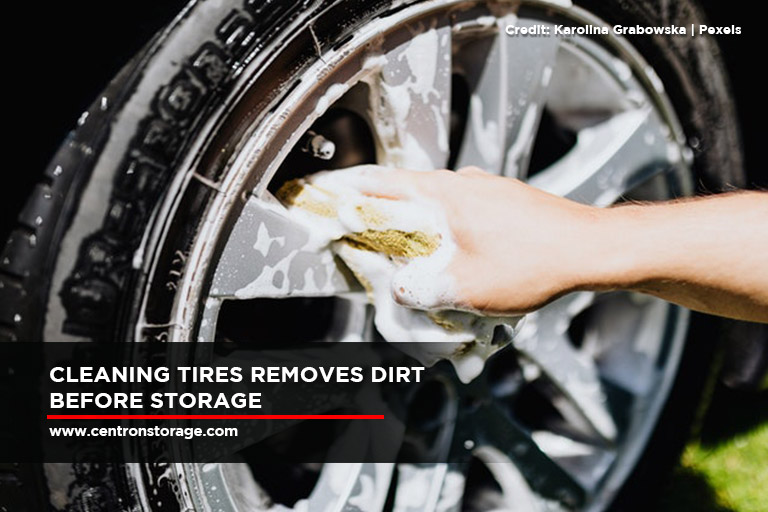
Clean your summer tires after they’ve been swapped for winter tires or vice versa. To remove road filth, dirt, and brake dust, clean them with a tire brush, soap, and water. Now is also an excellent time to look for indicators of wear on your tires, such as cracks, bulges, and uneven tread wear.
Tire dressing is not necessary. Tire compounds are designed to withstand ozone cracking and other environmental factors. Such products can actually shorten the life of your tires rather than help them last longer.
- Avoid the sun
Some argue that ultraviolet radiation is the most significant cause of tire aging. UV radiation and the heat from the sun are harmful to rubber and cause it to deteriorate prematurely. UV rays enter the rubber, causing it to dry up and eventually degrade the rubber compounds. The simplest strategy to avoid dry rot in tires is to keep them out of the sun as much as possible. - Cover each tire
Place each one in a large, airtight plastic bag, such as lawn and garden bags. Make sure the bag and the tire are both dry and then remove as much air as possible from the bag (you can use a vacuum cleaner to suck out as much as possible). Tape the bag shut and close it tightly. This airtight environment reduces oil evaporation from rubber compounds.
There are also tire storage caddies or tire totes available. These make it easier to transport and store tires while also keeping them clean and dust-free. They are not, however, airtight. If you choose to use them, bag the tires first before putting them in your tire tote.
- Store tires in a cool, dry environment
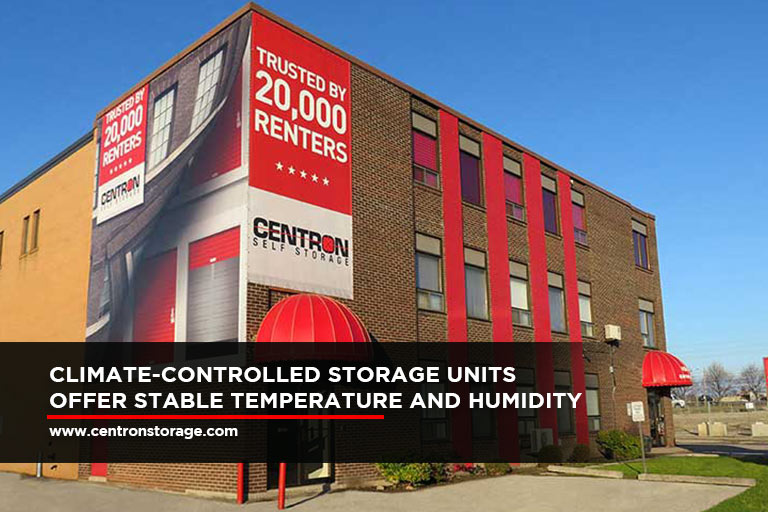
The most ideal tire storage conditions are cool and dry, with consistent temperature and humidity levels.
If at all possible, avoid keeping your tires outside or in a garage. These places are prone to sunlight and weather exposures. Another common option is the basement. If you’re storing your tires there, just make sure that they are kept away from furnaces, water tanks, sump pumps, and other ozone-producing machines. To keep a consistent atmosphere, consider renting a climate-controlled storage facility.
- Protect white rubber
Do your tires have whitewalls or other white components (such as lettering)? If you don’t want to bag your tires, store them with the white parts touching white and the black parts touching black.
On the white side, the black rubber is compounded differently than the black rubber on the other side. The white rubber on the tire’s white side is covered with a layer of non-staining black rubber to prevent oils in the tire from flowing into the exposed white rubber and discolouring it; however, the black sidewall is made of ordinary rubber. To keep white rubber bright and avoid blemishes, store it black-to-black and white-to-white.
- Avoid harmful products and chemicals
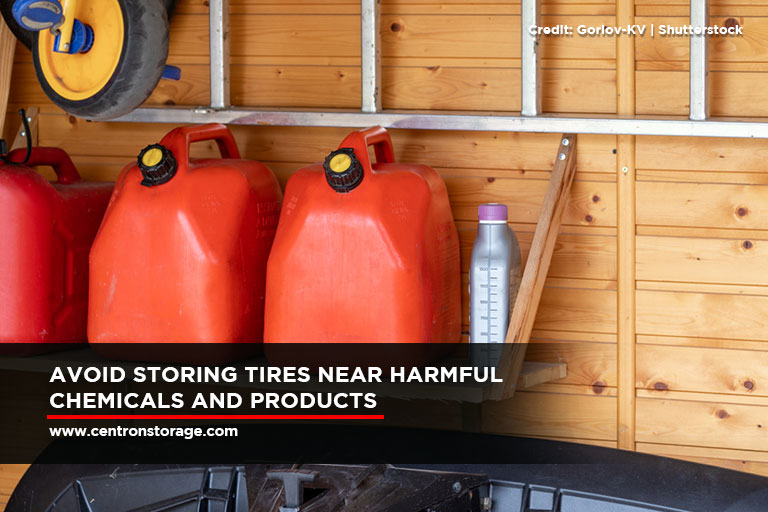
Don’t store tires in places near battery welding equipment, and electric motors, like furnaces, water heaters, central vacuums, generators, or a sump pump in the basement. These engines could create and emit tiny amounts of ozone, which isn’t good for tires in storage.
Exposure to hazardous materials and chemicals, such as petroleum-based products, gasoline or oil, and other solvents, can damage the weathering agents in rubber, causing premature cracking.
- Stack the tires properly
You generally have three options:- Stored upright.
- Laid flat on top of each other
- Hanged on hooks or wall mount tire rack
The proper way to store tires is normally based on whether your tires are still mounted on the rims or have been removed from the wheel before storage.
- How to Store Tires Mounted on Rims/Wheels
The best way to store mounted tires is with hooks into the rim. This removes the weight from the tire and lowers the possibility of the tire resting on a single flex point. Alternatively, you can stack them vertically next to each other. Unmounted tires should never be hung since they will deform and be damaged. - How To Store Tires Without Rims
Unmounted tires should be stacked sidewall to sidewall to avoid staining; white sidewall tires should be stacked white sidewall to white sidewall or placed individually in bags to avoid staining. It’s also preferable to set the tires on top of a piece of wood or another barrier rather than on the ground or concrete. This will help prevent excessive moisture from accumulating on the tires.
In either case, try to rotate their position every 4 weeks to help alleviate pressure on the other tires or the rim.
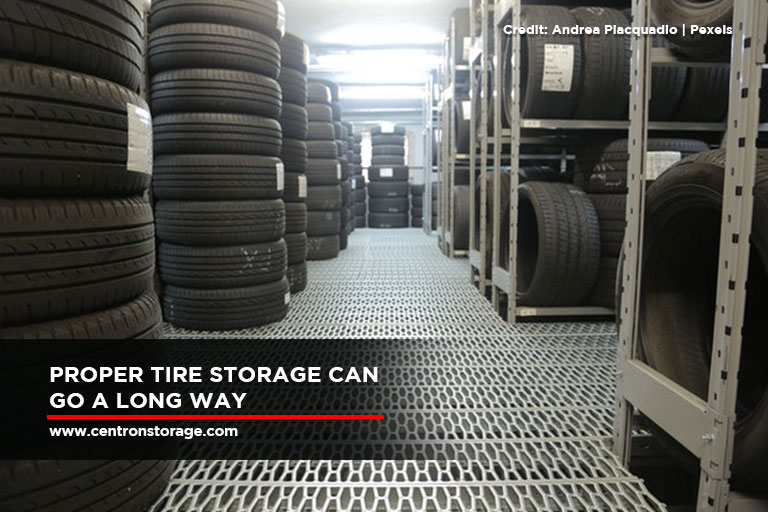
Tires are delicate objects, but a little tender loving care may go a long way. Although appropriate car tire storage may appear to be complicated, following these simple storage best practices and keeping an eye out for potential threats will help your spare set of tires last as long as possible.
Entrust your tires to Centron Self Storage. We offer clean and secure storage units in North York. Reserve yours now by calling us at (416) 739-0000!
5 More Tips for Storing Your Items Safely During the Winter
A great number of the items in most households are seasonal. Some of those that you’ll need in the summer will be useless in the winter, and vice versa. As a result, it’s critical to safely store these items to keep them in good condition.
Storing items during winter is easier said than done, however. The elements, the temperature, as well as a lack of use, can wreak havoc on your belongings. When it comes to protecting your personal belongings throughout the winter months, there are a few things you need to consider.
Here are some storage tips for winter:
How Do You Store Things for the Winter
- Decide What to Keep
The first step before putting your belongings in storage is to decide what you want to put away for the winter. Some of your possessions may not be worth storing and would simply take up room that could be better used for more necessary items.
Make a list of the objects you want to store, select what should be kept and what should be donated or thrown out first. Throw away anything that is broken, ripped, cracked, or beyond fixing. Decide whether you want to spend the time cleaning, painting, or reupholstering it if it’s just dirty, faded, or rusty. If the answer is no, donate it; if the answer is yes, put it on your list of things to keep.
- Clean Your Belongings
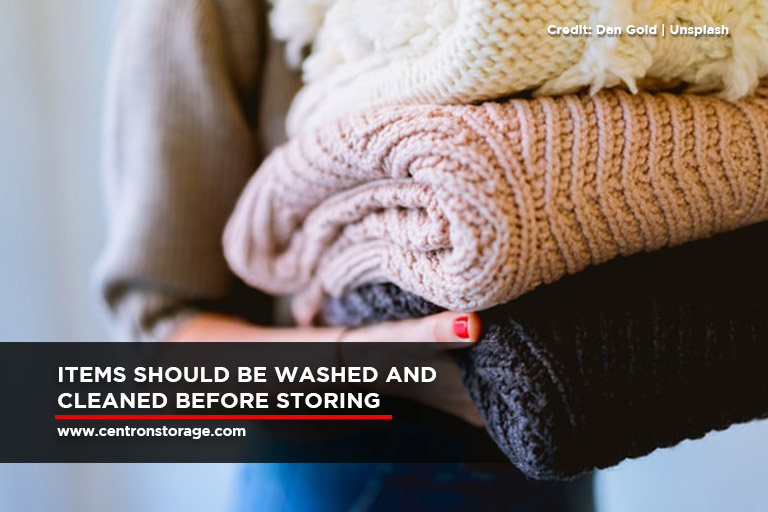
The simplest approach to keeping objects in winter storage from deteriorating is to always take extra precautions by carefully cleaning and storing each item. Allowing dust and dirt to sit with your belongings for months can cause a lot of damage.
Cleaning your belongings before keeping them protects not only the item but also the storage container. Make sure to dry your valuables after you’ve cleaned them. Water or moisture of any kind can cause issues, especially in the winter when liquids freeze and expand. Don’t forget to make all necessary repairs before storing your belongings, as well.
- Cover Your Items
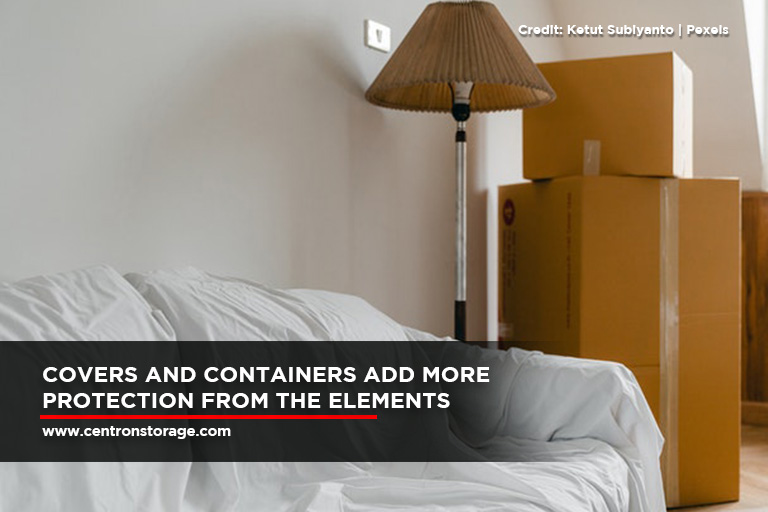
Covering your valuables is an excellent way to keep them safe. Covering your belongings offers an added layer of cushioning and keeps bugs, dust, and debris out. However, you cannot simply cover your things with any material. Plastic and vinyl are not recommended because they can collect moisture or water and break or split when exposed to the cold in the winter. Wool or fabric coverings are the best materials to safeguard your items.
Moving blankets are also a terrific way to keep your possessions secure for an extended period. Packing materials are also beneficial for maintaining heat and safeguarding any objects in boxes. You can also place your items inside plastic containers instead of cardboard boxes. Plastic bins are durable and offer more protection from moisture and anything else that could try to sneak inside.
- Keep Electronics Elevated
When electronics are exposed to extremely cold temperatures, they are easily ruined. So, if at all possible, take precautions to keep devices off the ground — put them on top of furniture, in boxes, or on shelves. The ground loses heat even in climate-controlled storage containers and is the coldest portion of the unit. Electronics left in this condition over the winter might be irreparably destroyed. - Choose Climate Controlled Storage
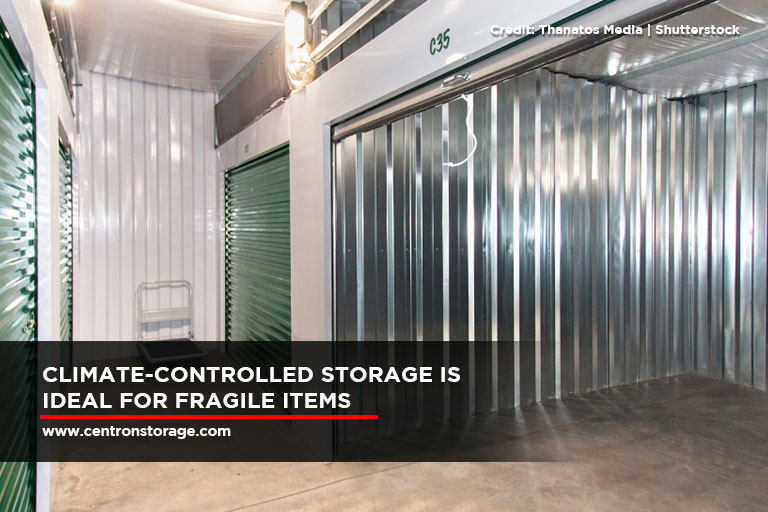
Climate-controlled storage containers are ideal for storing your belongings, especially those that are valuable or fragile. The cold may cause a lot of damage to a lot of things. Climate-controlled storage facilities protect your possessions from temperature-related harm, which is especially handy during the winter.
These storage units will keep moisture from accumulating and seeping into your electronic, motor-driven, rust-prone devices. Climate-controlled storage lockers are a sure-fire way to preserve all of your belongings in good shape.
General Tips to Storing Items During Winter
Storage during winter is tricky. There are several places where the temperature drops significantly below zero. So, regardless of the type of winter you have in your area, you’ll want to make sure your things are well-protected.
- Clothing
Before storing any fabric or piece of clothing, it must be thoroughly washed and dried. This is necessary to avoid mould. Also, clothes, especially those that aren’t totally clean, can attract pests.
When arranging your storage unit, it makes sense to stack clothes and fabrics as high as possible in your storage locker. The reason for this is that humidity is denser than air and tends to sink. This means that the higher you store your clothes, the drier the air is and the safer your garments are.
- Activity Equipment
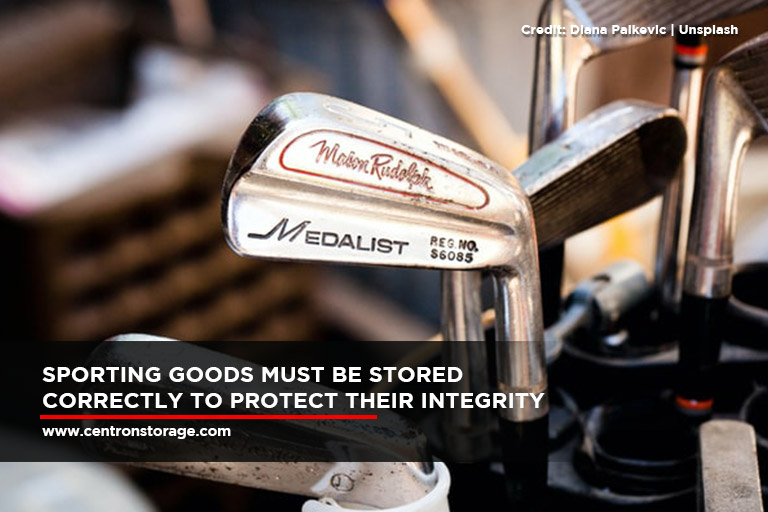
When it starts snowing, some equipment has to go. Winter storage for a camper is particularly important. Sporting goods and activity equipment don’t come cheap, and everyone understands that they are a significant investment. As a result, it would be a waste to harm perfectly good equipment by not properly storing them.
Like all other things, you have to clean them first correctly. It is not recommended for you to place them directly on the floor. If possible, hang them on a pegboard or place them on a pallet.
- Bicycle
To store a bike for the winter, there are a few measures to follow. Before storing the bike, make sure the tires are fully inflated, as the cold weather might cause them to lose air. If you’re storing the bike on the ground, flip it upside down or hang it on a bike rack to relieve pressure on the tires. Lubricate the brakes, bike chain, and cables to prevent rusting or moisture from entering into the bike and freezing parts. - Car
It is critical to take all necessary precautions when storing any sort of vehicle for the winter. Winter weather may cause problems with your car’s engine, battery, and brakes.
Before storing a car for winter, remove the batteries and empty the gas tank, as well as any other liquids in the vehicle. Check your tire pressure and make sure your car is covered with a tarp or other covering because cold weather might cause your tires to deflate.
- Equipment With An Engine
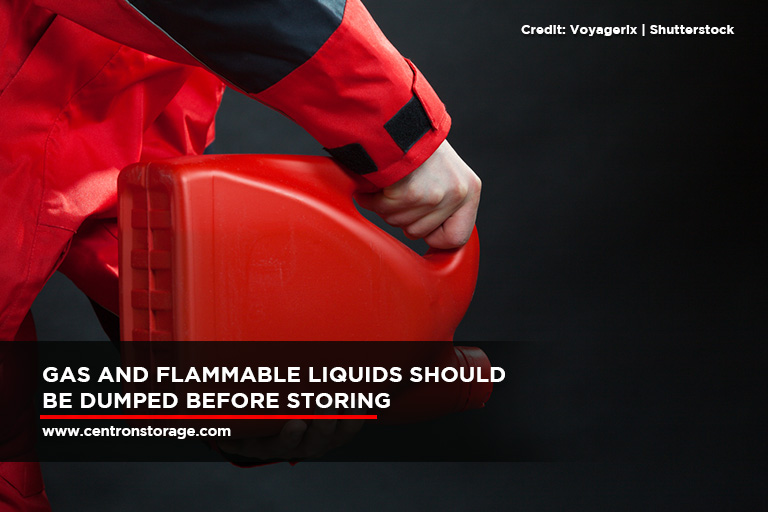
If you’re planning to store any type of engine-powered equipment (such as a lawnmower), make sure to empty the gas first. Remember that flammable liquids are not allowed in storage units.
Any old fuel that has remained in the tank for a long period can cause engine harm, so dump the tank to avoid having to make any repairs by next spring.
Also, make sure to clean the equipment thoroughly before storing it, and protect it with some form of cover.
Securing, preserving, and storing your assets effectively throughout the winter takes a lot of thought and effort. But, if you follow these tips, you will be relieved to find your belongings still in excellent shape next season.
If you are looking for a storage facility this winter, come to Centron Self-Storage in North York, Ontario. Reserve your unit now and keep your items safe by calling us at (416) 739-0000!
